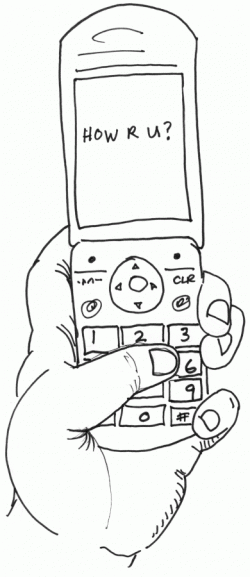U R 2 cool: Texting shorthand much older than phones
Q. How did the crazy new language of cell phone texting get its start anyway? –S. M. Garcia
A. Textisms may seem hip, streamlined, and clever; but they're hardly new, says David Crystal in A Little Book of Language. This surprises people, but such forms as "u" for "you" and "gr8" for "great" weren't just created for mobile phones but were actually used over 200 years ago! They were called "rebuses" (pronounced "ree-buses") and were a popular kind of puzzle. Queen Victoria used to play rebus games. So did Lewis Carroll.
"When I was a boy," says Crystal, "I used to get Christmas annuals which had rebus games, such as this row of symbols: YY U R YY U B I C U R YY 4 ME. Many adults will remember that one. It reads: 'Too wise you are, too wise you be, I see you are too wise for me.'"
Another surprise about textisms is how un-crazy many of them really are, with only about 10-20 percent of words being abbreviated. Of course you can find youngsters texting "what r u saying?" Or "i'll b there by 7." Or "u 2. Glad journey went OK." But there are more like the following: "Tropical Storm Barry has formed, located 320 miles (520 km) southwest of Tampa, Florida." "Barack has chosen Senator Joe Biden to be our VP nominee."
Most of the text messages flying around the world right now are sent by businesses, organizations, schools, colleges to transmit useful information– and they're meant to be readily understood.
Q. Which are you, a carefree carnivore? A vegetarian? A fruitarian? A pescatarian? A what? –J. Landers
A. The word "vegetarian" sprouted up in 1839, "fruitarian ("a person who lives on fruit") ripened in 1893, says The Merriam-Webster Unabridged Dictionary.
Then in 1993, those who eat fish but no other meat chose "pesce," Italian for "fish," to create the designation "pescatarian."
Because it's still relatively new, the word isn't familiar to many, meaning you just may have some of your listeners hungry for more (explanation).
Q. If the one-child-per-couple rule is strictly enforced in China, how long would it take before its population goes to zero? –M. T. Tung
A. Under ideal assumptions– such as all Chinese marrying exactly once, each couple having exactly one child, there being no immigration or emigration– the one-child-per-couple rule would cut the population in half every generation. Since China numbers approximately 1.3 billion people, which is roughly two doubled 30 times, it would take some 30 generations to approach zero population. Figuring about 20 years per generation, the time for this to happen is 20 x 30, or 600 years!
Q. It's known as the "head-up illusion," the "somatogravic illusion" or the "false-climb illusion" and is all too familiar to aircraft carrier pilots. What exactly is it? –C. B. Sullenberger
A. A jet plane taking off from a carrier is propelled by its powerful engine while also being catapulted forward, reaching takeoff speed after only a short distance on the deck, says Jearl Walker in The Flying Circus of Physics.
This acceleration acts like a gravitational force on the tiny hair cells of the inner ear, which the brain interprets as the head being tilted back. The erroneous signal is ignored if visual clues clearly indicate no tilt, such as when you’re accelerated in a car. But for a pilot being hurled along the deck of an aircraft carrier at night, the illusion of tilt can be so strong and convincing that the pilot believes the plane is heading upward too sharply.
"Without proper training, a pilot will attempt to level the plane by bringing its nose sharply down, tragically sending the plane into the ocean," Walker writes.
~
Send your Strange questions to brothers Bill and Rich.
